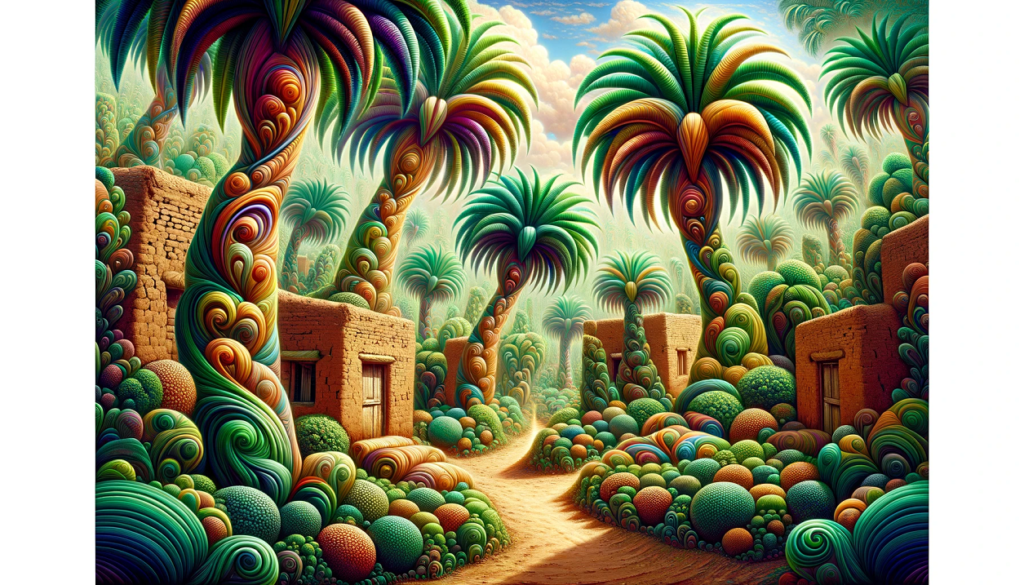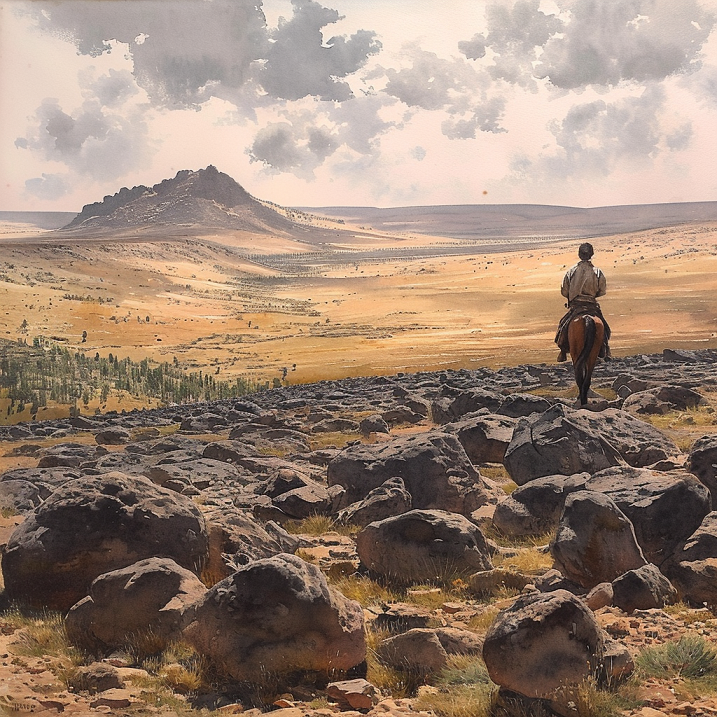In “A Pilgrimage To Nejd”, Lady Anne Blunt offers a vivid account of her journey through Arabia in the mid-19th century. Her narrative, rich in detail and observation, presents a unique glimpse into the lands and peoples of a region largely unexplored by Western travellers at the time.
Key Takeaways:
- The desert landscape is both beautiful and challenging, requiring keen survival skills.
- Cultural exchanges enrich the travel experience, providing insights into local customs.
- Political discussions reveal the complex social dynamics of the region.
- Natural resources like water wells are critical yet scarce in the desert.
Blunt’s writing style combines the keen eye of an ethnographer with the sensibility of a traveller, transporting us to an Arabia of the past, a world of stark landscapes and traditional villages, two of which we cover here, and the enduring spirit of its people.
Lady Anne Blunt delves into the heart of her Arabian journey, describing her experiences in the central Arabian villages of Kaf and Itheri. Her vivid portrayal of Kaf as a charming, miniature-like village distinct from anything seen in Syria is particularly striking. Blunt describes the sixteen little square houses, the quaint battlemented towers, and the walls standing only seven feet high, all of which contribute to the unique character of Kaf. The presence of seventy to eighty palm trees in a garden watered from wells, along with delicate tamarisks, paints a picture of an oasis amidst the arid landscape.
Her observations extend beyond the architecture to the people of Kaf. Initially, the sight of everyone carrying swords was startling, but Blunt notes the good-natured demeanour of the villagers, contrasting with her initial apprehensions. The hospitality shown by Abdallah el-Kamis, the Sheikh of the village, is a testament to the courteous and civilised nature of the inhabitants.
We are much struck with the politeness of everybody. Abdallah, our host, asked us at least twenty times after our health before he would go on to anything else ; and it was not easy to find appropriate compliments in return.
Lady Anne Blunt: A Pilgrimage to Nejd, The Cradle of the Arab Race
Itheri
Lady Anne Blunt’s journey to Itheri adds further depth to her Arabian expedition. In Itheri, she encounters a village smaller than Kaf, yet notable for its ancient building and miniature castle. The architectural uniqueness of Itheri is highlighted by the use of black stones in construction, a stark contrast to the common mud material prevalent in the region. An intriguing aspect of Itheri is the almost illegible ancient inscription on the lintel of a doorway, possibly Himyaritic, which speaks to the historical richness and mystery enveloping the area.
We were told that this inscription related to hidden treasure, a common fancy among the Arabs who cannot read.
Lady Anne Blunt: A Pilgrimage to Nejd, The Cradle of the Arab Race
In Itheri, Blunt’s interactions with the locals, particularly with Jeruan, a half-witted young man with a distinctive appearance, and his mother Merzuga, provide insights into the social dynamics and familial relations within the village. Merzuga, despite having an unintelligent son as the eldest, is portrayed as an intelligent and well-bred woman, indicating the diverse range of personalities encountered by Blunt.
Her detailed account of the palm garden in Jeruan’s possession and the admiration for the ithel trees and the rare hellua variety of date from Jof showcases the agricultural richness and the pride the locals take in their produce. Through these descriptions, Blunt effectively conveys a sense of the everyday life and the cultural nuances of the people in Itheri.
Wilfrid describes the walk in the garden as rather amusing, Mohammed and Abdallah making long speeches of compliments about all they saw, and telling Jeruan’s head man extraordinary stories of the grandeur and wealth of Tudmur. Jeruan’s garden, the only one at Itheri, contains four hundred palm trees, many of them newly planted, and none more than twenty-five years old. Amongst them was a young tree of the hellua variety, the sweet date of Jof, imported from thence, and considered here a great rarity. At this there was a chorus of admiration.
Lady Anne Blunt: A Pilgrimage to Nejd, The Cradle of the Arab Race

Lady Anne Blunt’s account of her Arabian odyssey continues with the journey towards Jawf, a segment filled with natural challenges and cultural revelations. She describes the landscape as being similar to the Harra, with volcanic stones and a fierce south-east wind impeding their progress. This part of the journey is marked by encounters with wildlife, including red locusts, which the party hunts for sustenance. Blunt’s description of these locusts – their flight patterns and behaviour – reflects her keen observational skills and interest in the natural world.
Saw great numbers of red locusts which, as the sun warmed the ground, began to fly about and were pursued by the men and knocked down with sticks. Enough have been secured to make a dish for dinner.
Lady Anne Blunt: A Pilgrimage to Nejd, The Cradle of the Arab Race
One of the most striking aspects of this segment of her journey is the acquired skill in identifying pastures. Blunt and her party, through experience and keen observation, have come to recognize that rocky grounds arranged in lines often signal the presence of pasture. This knowledge is invaluable in a terrain where the scarcity of vegetation can pose a significant challenge to travellers.
End of the Year at Wadi Sirhan
As the year drew to a close, Lady Anne Blunt’s depiction of her experiences in the desolate reaches of the Wadi Sirhan in “A Pilgrimage To Nejd” captures the stark beauty and harsh realities of the Arabian desert. The author conveys the profound sense of isolation felt in one of the most desolate places on earth. The cold of the desert night is so intense that it results in the death of locusts, a poignant reminder of the unforgiving nature of the desert climate.
In their journey through the main bed of the Wadi Sirhan, Lady Blunt and her party encounter a landscape that is nearly flat, covered with large bunches of guttub and other shrubs. The mention of the vegetation being very salt to the taste provides a sensory detail that enhances the reader’s understanding of the desert flora. The soil, described as crumbly and unsound, and in places white with saltpetre, adds to the sense of a barren and inhospitable landscape, further emphasising the challenges faced by travellers in such an environment.
One of the most intriguing aspects of this section is the mention of quicksands, known locally as hadda. Members of Lady Blunt’s party, share local lore about these dangerous areas, where everything that passes over them – men, camels, and gazelles alike – is said to sink and disappear without a trace. Although Lady Blunt and her companions see no sign of these quicksands, the mere existence of such tales adds an element of danger and mystery to their journey.
Coasting the edge of the Wady, we came suddenly on some gazelles, which led us to higher ground, where we found a stony wilderness of the Harra type; and amongst the stones we saw a hyaena trotting leisurely. We got nothing, however; neither him nor the gazelles, and are still without meat.
Lady Anne Blunt: A Pilgrimage to Nejd, The Cradle of the Arab Race
Traversing Wadi Sirhan
In her compelling account of traversing the Arabian deserts, Lady Anne Blunt provides vivid details of the journey’s continuation, marked by a blend of natural beauty and the rugged challenges of desert life. The narrative, set against the backdrop of the vast and desolate Wadi Sirhan, located in the northwest of the Arabian peninsula, reflects the quintessential essence of exploration in the mid-19th century.
The section opens with the travellers’ cautious approach towards camping, particularly their decision to camp under a cliff hollowed out into caves. This choice, while offering shelter, is also tinged with the fear of potential enemies, reflecting the constant vigilance required in such untamed landscapes. The beauty of the location, however, is not lost on Lady Blunt, who notes the enchanting view of the Mizmeh hills, capturing the stark yet mesmerising beauty of the Arabian terrain.
The journey through the Wadi Sirhan is also an opportunity for political discourse and learning. Lady Blunt engages in discussions about the political climate of Hail, particularly concerning the ruler Ibn Rashid. This dialogue enriches her understanding of the region’s complex social and political dynamics. The contrast between the amiable nephew Tellal and the more fearsome reputation of the present Ibn Rashid adds depth to the narrative, illustrating the ever-changing nature of leadership and power in this part of the world.

New Year’s Journey
The advent of the New Year brings a new phase in Lady Anne Blunt’s expedition. This segment of the journey heading southwards, through the Nefud Desert, onwards to Hail, specifically on January 1, 1879, is marked by a change in direction and a deeper immersion into the stark yet captivating desert landscape.
Travellers Diet
Their day begins at the first glimpse of dawn, with a simple breakfast of coffee and a biscuit or rusk, followed by a long march until the afternoon. This regimen, devoid of luxuries, underscores the travellers’ resilience and the need for efficiency in such a challenging environment. The mention of their diet, primarily consisting of beef tea, burghul, dates, and occasional treats like fried onions or flour mixed with curry powder and butter, offers insight into the practical and frugal nature of sustenance in the desert.
A fortunate encounter with a desert hare provides a rare opportunity for fresh meat, a luxury in the austere desert conditions. This moment of small triumph in an otherwise monotonous and strenuous journey highlights the significance of even the simplest pleasures in the vast and unforgiving desert.
The desert hare is very little bigger than a large rabbit, and is literally too much for one, and not enough for two ; but Mohammed magnanimously foregoes his portion, and says he can wait.
Blunt’s journey through Arabia, with its vivid descriptions and insightful observations, remains a valuable contribution to the understanding of a region and its people during a time of great change and intrigue. Her work endures as a remarkable account of exploration and discovery in the Arabian Peninsula.
FAQ:
Q: What was the main purpose of Lady Anne Blunt’s journey?
A: To purchase Arabian horses from deep within the heart of Central Arabia.
Q: How did Lady Anne Blunt adapt to the desert environment?
A: By learning to identify pastures and using local resources like fried locusts for sustenance.
Q: Were there any significant challenges faced during the journey?
A: Yes, they faced harsh landscapes, unexpected attacks, and personal ailments like illness and injuries.
Q: Did Lady Anne Blunt interact with local tribes?
A: Yes, she had various cultural exchanges and learned about local politics and social structures.
Q: How did the journey influence Lady Anne Blunt’s view of the desert?
A: It deepened her appreciation for its beauty and the resilience required to navigate its challenges.
Q: What does the arrival at Jof signify in the journey?
A: It marks the successful completion of a challenging phase of the expedition and a transition to a new environment.

